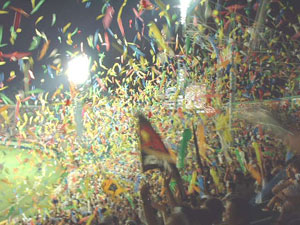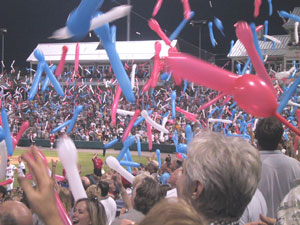







|
| Dametora | When the Tigers are playing poorly and falling behind in the standings, they are called dametora, but only by non-Kansai residents. Hanshin fans, no matter how bad the season might seem, never give up on their Tigers. |
| Dento no issen | This is the name for the games between the Tigers and the Yomiuri Giants (Kyojin), Tokyo's main team. The rivalry between the two teams is almost as intense as the rivalry between the two cities. |
| Jetto fusen | These are the long balloons that Tigers fans, especially those in the bleachers, release at the start of the bottom of the seventh inning. They are also referred to as roketto fusen. The balloons make a whistling noise as they fly and create an amazing racket when everyone releases them at the same time. |
| Mouko | Fierce Tigers. This is what they are called when they are playing well. |
| Rakki sebun | Lucky 7, the seventh inning. Tradition says this is the strongest at-bat for the Tigers, when they often score runs to come from behind. When Hanshin plays at home, the stadium makes an announcement over the loudspeakers in the middle of the inning to remind everyone to cheer even harder during Lucky 7. |
| Shi no rodo | These are the so-called deadly road games (literally, "road of death"). For two weeks in August, while the high school baseball tournament is at Koshien Stadium, the Tigers mostly play road games, with maybe one series at Osaka Dome. The team typically doesn't do well during this period. |
| Taigasu fan | Tigers fan |
| Torakichi | Someone crazy about the Tigers, or a Tigers fan. The word is derived from tora, meaning tiger, and kichi, which is short for something unprintable, meaning crazy or insane. |
| Torakki | (Tracky, To-Lucky) The Tiger's male mascot. The female mascot's name is Lucky. | -from Kaoru Horiuchi's article in "Kansai Time Out", May 1996. 
Jetto fusen in action at Koshien

And can you believe it? Frisco, Texas on July 3rd 2003.
A Tigers tradition has now even made it over to the USA!
 |